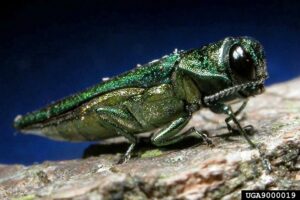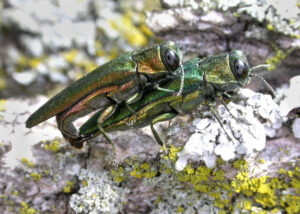 |
 |
 |
 |
Origin and Introduction to North America
The Emerald Ash Borer (EAB), scientifically known as Agrilus planipennis, is an invasive beetle species that has caused significant damage to ash trees across North America. The EAB is native to eastern Asia. It was unknown in North America until 2002 when it was discovered in Detroit. It is believed to have arrived accidentally in cargo imported from Asia. Since its initial detection in Michigan, the EAB has spread to at least 36 US states. The beetle is well-suited to our climate, is a good flyer, and spreads naturally. People contribute to the long-distance spread of the beetle when they move EAB-infested ash firewood, logs, or nursery stock.
Emerald ash borer in Texas
The EAB was first detected in Texas in April 2016 in Harrison County. Since then, it has spread to at least 21 Texas counties as of June 2024. The most recent counties with positive identifications of the pest are Collin and Johnson Counties. Many Texas cities have ash trees as part of their urban landscapes, which could soon come under attack from the rapid spread of the EAB. Urban forests are being impacted as the insects move south.
Impact on Ash Trees
The EAB lays its eggs in the bark crevices of ash trees. The eggs hatch and the larvae burrow into the tree where they feed. This feeding damages the trees, leading to their decline and eventual death. EAB infestations are difficult to detect early when pest populations are small because damage to the trees is hidden under the bark. The EAB has been responsible for the death and decline of tens of millions of ash trees in North America. Ash trees lose most of their canopy within 2 years of infestation and die within 3-4 years. Without proper proactive measures, mortality can be 100% in certain areas, so early detection is key.
Prevention and Treatment
To prevent the spread of EAB, it is advised to buy only local firewood or certified heat-treated firewood. In areas with known infestations, protective insecticidal treatments can be applied to protect ash trees. Trees with confirmed attacks should be removed and destroyed to avoid new beetles emerging. Ash firewood should not be transported to avoid the introduction of the insect in new counties.
Conclusion
The EAB poses a significant threat to ash trees in the United States and Texas. Efforts are ongoing to monitor its spread and mitigate its impact. Early detection and appropriate preventative measures are key to protecting our ash trees from this invasive pest.
Reference Materials and Additional Resources:
ALERT: Emerald Ash Borer found in DFW Metroplex – Texas A&M Forest Service:
- EAB Handout
- Urban and Community Forestry
- Statewide Summary of Potential Impacts of Emerald Ash Borer
AgriLife Today article, May 15, 2024:
Texas Invasives:
North Central IPM Center -List of products:
USDA APHIS:
Hudgins, Emma J., et al. “Spread Management Priorities to Limit Emerald Ash Borer (Agrilus Planipennis) Impacts on United States Street Trees.”
Conservation Science & Practice, vol. 6, no. 3, Mar. 2024, pp. 1–14.
EBSCOhost, https://doi.org/10.1111/csp2.13087.
Sheng, Z. H., et al. “Suitable Habitat Area Analysis and Niche Assessment of the Invasive Emerald Ash Borer (Agrilus Planipennis) in Native and Invasive Ranges.”
Applied Ecology & Environmental Research, vol. 22, no. 2, Mar. 2024, pp. 1885–902.
EBSCOhost, https://doi.org/10.15666/aeer/2202_18851902.